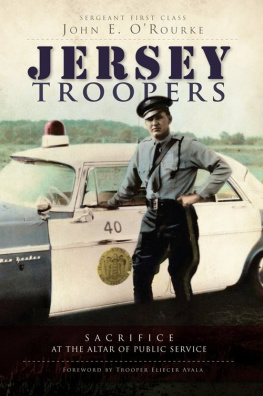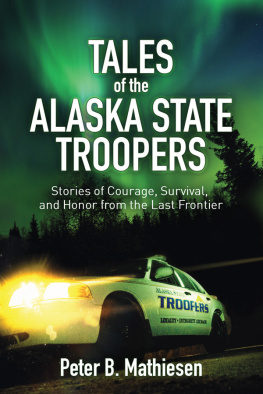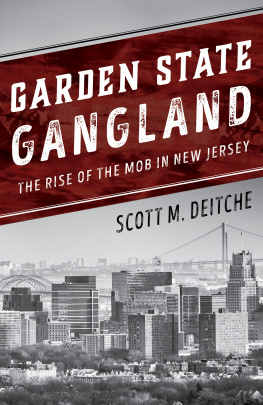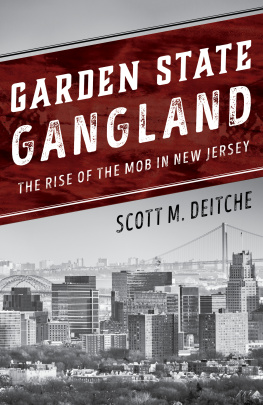JERSEY
TROOPERS
SERGEANT FIRST CLASS
J OHN E. OR OURKE
---------------------------------------------------------------------------------------
JERSEY
TROOPERS
SACRIFICE
AT THE ALTAR OF PUBLIC SERVICE
Published by The History Press
Charleston, SC 29403
www.historypress.net
Copyright 2010 by John E. ORourke
All rights reserved
All images courtesy of the New Jersey State Police Museum unless otherwise noted.
First published 2010
e-book edition 2011
ISBN 978.1.61423.021.2
Library of Congress Cataloging-in-Publication Data
ORourke, John, 1962
Jersey troopers : sacrifice at the altar of public service / John ORourke.
p. cm.
print edition: ISBN 978-1-59629-978-8
1. New Jersey. Division of State Police--History. 2. Police--Mortality--New Jersey--Case
studies. 3. Traffic fatalities--New Jersey--Case studies. 4. Police--Violence against--New
Jersey--Case studies. I. Title.
HV8145.N5O76 2010
363.20922749--dc22
2010010750
Notice: The information in this book is true and complete to the best of our knowledge. It is offered without guarantee on the part of the author or The History Press. The author and The History Press disclaim all liability in connection with the use of this book.
All rights reserved. No part of this book may be reproduced or transmitted in any form whatsoever without prior written permission from the publisher except in the case of brief quotations embodied in critical articles and reviews.
CONTENTS
FOREWORD
T he New Jersey State Police was established in 1921, primarily to provide police services in rural areas of the state. The person who is most credited with establishing the state police and having the biggest impact on its formation was the first colonel, H. Norman Schwarzkopf. Prior to his position in the state police, Schwarzkopf was a graduate of West Point, serving as an officer in the U.S. Army. His military background greatly influenced the manner in which the state police was established, putting into place the strict discipline and military bearing that the Outfit is known for. He planted and cultivated the seed that would eventually become an organization rich in tradition and established practices.
Two of the most familiar and recognized aspects of the state police are the triangular badge, only worn on the hat, and the sharp French blue uniform, both of which have remained virtually unchanged through the years. The hat that is always worn by the trooper is adorned with the triangular badge that has the seal of the state and the troopers badge number. The coveted number runs sequentially and is only assigned once, never to be reused. Each corner of the badge is occupied with a star, the stars representing the core values of the state police: Honor, Duty and Fidelity. The smart and crisp uniform worn by the road duty trooper, or Road Dog, is similar to the uniform of the very first troopers who went out on patrol on motorcycle or horseback. Unlike other police agencies, the state police has chosen to maintain the traditional look instead of adopting a more tactical style that has become en vogue.
What has evolved over the years is the function of the state police. To meet the needs of the state, the agency has diversified into many specialties. Troopers today may have state-of-the-art equipment in their cars and stations, in step with the times, but some aspects of being a trooper still remain. Ask any trooper about his or her first station assignment and he or she (that also has changed) will probably recount coming an hour before his or her shift to clean the station and make the coffee for the squad. Or they may tell how the senior, more experienced troopers sometimes refer to them as recruits, in spite of the fact that they graduated from the academy, until they prove worthy of the title of trooper.
Experiences such as these are what bring us together, forming the fraternity of the Jersey trooper within the state police. Retired or active, we all share this common experience. It is because of traditions such as these, passed down from generation to generation, that a strong sense of brotherhood exists within the organization. It sets the trooper and the state police apart from all police.
John ORourke is attempting to give you, the reader, insight into these brave men and the ultimate sacrifice that they paid. Most lost their lives in motor vehicle accidents; others suffered serious injury or illness that eventually caused their premature death, while others were murdered. No one death is more tragic than another; what is true is that some are more recognized and celebrated than others. The author wants to personalize these special individuals and remember each equally. At its conclusion, I can only hope that you come away recognizing that this organization has been fortunate to have had in its rolls special people of many different backgrounds but with one common purpose: to serve the citizens of the Garden State. Let us not forget those who wore the uniform before us and always remember those special troopers whose lives were tragically taken.
Trooper Eliecer Ayala #5555
ACKNOWLEDGEMENTS
I would like to thank the following people for their help for this volume: Mark Falzini (NJSP archivist); Thomas Cavallo; Joseph Wurtz; James Principe; Ronald Perozzi; Hugo Stockburger; William Baldwin; George Rose; Deanna (In & Out Deli); Denise Zimmerman; Donna (Yenser) Dawes; Lieutenant Colonel Joseph Flynn; Lieutenant Colonel Lou Toronto; Barbara (Perry) Adams; Patricia and Eileen Walter; Ann McManus; Barbara (Dancy) Hubscher and her daughters Cathy and Carole; David Dancy; Debbie Lamonico; Helen Hartwiger; Peggie and James Wirth; Virgina Scotland; Douglas Scotland; Peggy Mallen; Maureen Gonzalez; Patrick ODwyer; Jeffrey Oslislo; Robert Monacelli; Gerald Dellagicoma; Cynthia Hetherington; Theresa Deehan; Robert Hanley; Colleen Lupo; Spencer Hildebrand; Robert Vargus Sr. and Robert Vargus Jr.; Betty Beylon; Peter Ardito; Francis OBrien Jr.; Keith OBrien; Monsignor ODonnell; Monsignor Shenrock; Walter Gawryla; James Conn; James Wirth; Margarete Wirth; Patricia (Walter) Debbie; Eileen Walter; Sandra (Welenc) Pennipede; Mary Ann Yuengling; Colonel Joseph Rick Fuentes; Kevin Burke; Michael Parmenter; Colonel Clinton Pagano and Catherine Hudak for telling me about The History Press.
I would also like to thank the New Jersey State Police, Former Troopers Association, the Survivors of the Triangle and all those public, county and state libraries too numerous to mention, which helped tremendously with my research.
For those who I have failed to list, please forgive my omission and know that each and every one of you who have helpedwhether big or smallI am deeply grateful.
Special thanks go out to Eliecer El Ayala for his help in making this book possible. Lastly, I would like to thank my wife, Ann, and my two children, John and Joanna, for putting up with my project for all these years.
BLOOD POISONING
William H. Marshall #63
A ugust 18 was a hot summer day in the year 1899, especially so in the city of Newark. The city and date are significant because it is there and then that William Henry Marshall was born. One of the three oldest cities in the United States, Newark was a leader in the industrial establishment. It had tremendous growth in manufacturing and success both in banking and insurance development. It was a time when William McKinley was president, Foster Voorhees was governor of New Jersey and the horse and buggy was the main mode of transportation.
Next page










